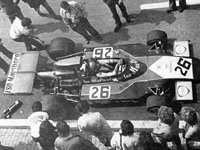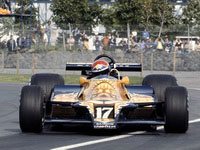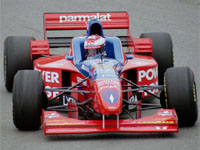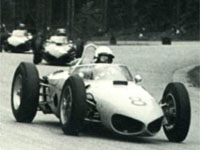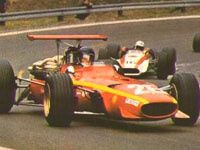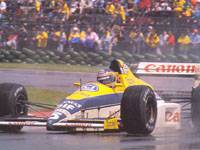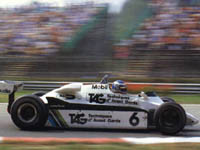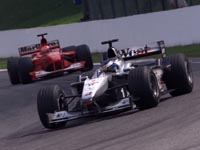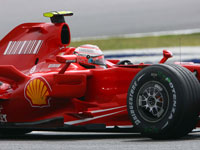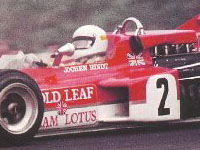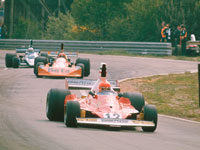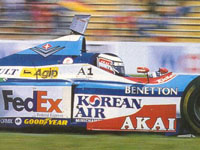Does size really matter?
Author
- Mattijs Diepraam
Date
- July 7, 2011
Related articles
- France - France's final golden age, by Mattijs Diepraam
- Italy - Everything is Ferrari, by Mattijs Diepraam
Who?Jos Verstappen What?Benetton-Ford B194 Where?Spa When?1994 Belgian GP (August 28, 1994) |
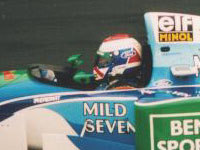 |
Why?
The large countries in Europe have always dominated proceedings in motor racing. As in all sporting domains, strength is usually in numbers. By law, small countries never stood a chance. Evidence, however, is increasingly stacking up against this conventional wisdom. Both France and Italy are close to hitting rock-bottom on motor racing’s world scale of importance while politically and industrially insignificant nations such as Austria and Finland have continued to produce superstar drivers and even champions over the past few years. Does size really matter?
It seems simple. A large number of inhabitants is guaranteed to create a larger talent pool, which in turn is better nurtured by a larger number of motor racing facilities spread across a larger territory, and supported by a larger number of wealthy and influential companies with a need to make a name for themselves internationally. Therefore it seems only logical that Britain and Germany today are at the forefront of international motorsport, both talent-wise and technically.
The Netherlands and Belgium are fine examples of what it means to sit at the other end of the scale. Although densely populated, the Low Countries are dwarfed by their large neighbours France, Britain and Germany. This has been reflecting itself in the relatively minor roles the two nations have played in motorsports, in spite of legendary circuits such as Zandvoort, Spa and Assen. Holland’s motorsport talent especially has been pulling the shortest straw since the dawn of motor racing – or so it often said. The three Le Mans victories by Gijs van Lennep and Jan Lammers, two Indy 500 victories by Arie Luyendijk, a Monte win by Maurice Gatsonides and a couple of F1 podiums by Jos Verstappen form the total sum of internationally acclaimed achievements by Dutch-born drivers. Usually, the small size of their country is blamed as the cause.
But does it really work this way? Let’s now take a look at Belgium, closely connected to the Netherlands through its history and language. Its economy pales in comparison with that of the Dutch, who have been riding the waves of international trade, finance and industry since their Golden Age in the 17th century. With their 16 million inhabitants, compared to Belgium’s 11 million, the Netherlands are a G20 nation when measured by its impact on the world economy. Belgium doesn’t even come close, and per capita their figures are even worse. The same goes for Denmark or Norway, both of which only have Tom Kristensen and Martin Schanche to show for, as would be fitting for a nation that’s about the same size as Belgium, and with the same minimal economic importance. Yet Belgium did produce Olivier Gendebien, Jacky Ickx and Thierry Boutsen, i.e. a sportscar hero and multiple Le Mans winner and two multiple Grand Prix winners, one of which came close to the World Championship. In terms of bang for bucks, that’s a huge up yours to the northernly neighbours. How did they do that? And conversely, why have the Dutch, with their relative economic might, failed to produce a Grand Prix winner?
The answer is probably culture. To understand what this means in motorsport terms we need to time-travel to motor racing’s earliest history. Two events in the Low Countries jump out at us as being pivotal in the trajectory that motorsport would follow in either nation. Remarkably, in the Netherlands, the 1898 Paris-Amsterdam-Paris race was to remain the only internationally significant motorsport event that Holland would see until the first Zandvoort GP in 1948. This traditional city-to-city event sparked off a Dutch interest in cross-country rallying that would marginalize any attempt to go circuit racing.
In Belgium however, the Circuit des Ardennes became the first European road-racing event in which the cars would go round in circles on a closed circuit, creating what we would now call ‘laps’. Its founder, and winner of the 1903 edition, Baron Pierre de Crawhez, became a prominent sponsor of this new form of racing. Another Belgian, Camille Jenatzy, grew into one of the best circuit racers of the era, with Theodore Pilette also featuring on occasion. Compared to Dutchmen, Belgian drivers seemed to be better placed to match up with French or German manufacturers, probably also helped by the fact that they had this great circuit right in their backyard. The Circuit des Ardennes, combined with the Malchamps hillclimb to Francorchamps, led to the formation of a Spa Automobile Club and eventually, in the early twenties, to one of the greatest racing tracks in the world, the Circuit de Spa-Francorchamps.
The Netherlands, meanwhile, were still in motor racing’s stone age. A few rugged types began competing in international rallying events such as the Monte Carlo Rally, the Coupe des Alpes and Liège-Rome-Liège, the latter event showing that the Belgians also had a headstart on the Dutch when it came to racing on the open road. ‘Bud’ Bakker Schut, Maus Gatsonides, Piet Nortier, Carol Schade and Lex van Strien shone in their imported American and British cars but were hardly performing as the disciples of a Dutch motoring industry of its own. In the thirties, several attempts to create Holland’s first motor racing circuit failed miserably, leaving MG minnows Hans Herkuleyns and Eddie Hertzberger as the only Dutch drivers comparing themselves with the great sportscar drivers of their time. Only right at the end of the decade, Holland’s very first circuit meeting came to be on the streets of Zandvoort.
Earlier, the circuit racing was done – and only on occasion – on horse tracks (Duindigt), athletics tracks (Woudesteyn), bicycle board tracks (Bergen op Zoom), boulevards (Scheveningen) or airfields (Leeuwarden). The plans for permanent racetracks at Arnhem and Zeist fell through. The Arnhem scheme involved a 35km circuit through the foresty hills of the Veluwe area in the heart of the country, only comparable to the Nürburgring and the Deutschlandring. It was a grand scheme that shrunk over time to eventually crumble to bits. Other projects at nearby Planken-Wambuis and Spelderholt also failed, and the same fate befell the Heksenberg circuit near Heerlen, in the south of the Netherlands, where the country’s only ‘mountains’ can be found. A project near Zeist, on the ‘Krakeling’ area, came closest, and even competed with Zandvoort in the immediate post-war years, before the local authorities stalled on the initiative, allowing Holland’s racing community to switch their allegiance to the town in the dunes and its enterpreneurial mayor.
Zandvoort’s presence wouldn’t mean that Holland could now play catch-up to Belgium. Post-war, the two nations’ motor-racing cultures would continue to be worlds apart. In Belgium, the national racing scene thrived on local tobacco money provided by Belga and Bastos. The infrastructure that was created around Spa and Zolder today still helps to connect Belgium to the international racing scene, with its GT and touring car championships almost always complying to the regulations that happen to be de rigueur all across Europe. No such thing in the Netherlands. Large companies such as Philips and ING have recently backed F1 teams but have never shown the slightest interest in supporting the local racing scene or their national talent. Zandvoort monopolizing all track action didn’t help either. Even today, with Zandvoort joined by Assen since the early nineties, Holland’s motor-racing economy is split between them, the two circuits competing with each other with separate championships.
If lessons are to be learned, two other small European countries have been showing the way for decades now – from Rindt to Rosberg, from Niki to Mika. Culture seems to be the operative word here, too, instead of infrastructure. Finland’s circuits have never featured in any meaningful international championship, yet the culture of driving a car fast is firmly embedded in Finnish society. This is of course borne out by the huge over-representation of Finns in international rallying – in fact, off-set against the country’s 5 million inhabitants that’s a dominance easily crossing the borders of the ridiculous – but in circuit racing the Finns have come on strong as well, not just with their World Champions Rosberg, Häkkinen and Räikkönen, and regular points scorers such as Salo, Lehto and Kovalainen, but also having grown into some sort of Scandinavian Brazil in terms of their mass supply to the lower formulae. Foremost, it’s their folklore tradition of around-the-lakes rallycross that can be practised from a very young age, and the most stringest driving test in the world that makes the Finns into such excellent allround drivers. They are what Ethiopians and Kenyans are to long-distance running – the Finnish environment forms a basic premise to their skill.
Austria is another story, being a minor EU member that used to be influential in all of Central Europe. Here, being part of the Germanic culture that is prevalent in the heart of the Old Continent, including having German as the state's official language, was and continues to be a great help. Ever since the thirties Germany and Austria's motor racing endeavours have been closely entwined. Many Austrians have raced in Germany in their formative years or in fact their entire careers while the likes of Hans Stuck and Ferdinand Porsche chose Austria as a safe haven after World War II. Today, the great years of Rindt, Lauda and Berger seem long gone but thanks to Dietrich Mateschitz's Red Bull the Austrian anthem has now been heard at Grands Prix some twenty times to celebrate the winning constructor - an all-new sensation in the small country's relatively successful history in motor racing. It shows that one large company interested in the image exuded by dangerous sports action can make all the difference.
So what it needs for a small country to breed success in motor racing is culture and money. If one of these two wells dries up nothing can ever be expected. In fact, the same goes for large countries as well. As we've seen in our two previous nations stories on France and Italy, it was lack of money that stymied the development of French talent, while the Ferrari cult in Italy has been detrimental to the development of a broad and diverse top-line motor racing scene.

